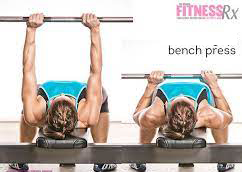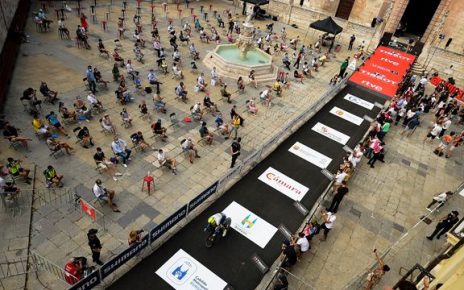Many exercise programs for women revolve around using fixed machines to shape a particular muscle group and they shy away from using free weights (i.e., barbells and dumbbells). This means that multiple exercises are often needed to activate large muscle groups like the chest. In contrast, free-weight exercises tend to be more general and activate several regions of the chest within a single lift. For example, the barbell bench press will strongly activate the lower, outer and middle parts of the chest. It’s really an all-around excellent exercise for improving the quality and fullness of your entire chest, but it will also firm your shoulders, muscles of the rib cage, some upper back muscles and arm extensor muscles.
You may be thinking that the bench press is a testosterone-saturated exercise reserved for hardcore male lifters and football players. What you might not appreciate is that plenty of female athletes have successfully used bench presses to improve their upper body strength in sports as diverse as swimming, volleyball and tennis, to name a few. While a champion women’s bench presser in the 105-pound weight class might lift 220 pounds, which is pretty good by any standards and more weight than some guys can handle, this doesn’t mean that every woman should bench twice her bodyweight to achieve the most from this exercise. A strict lifting form with adequate resistance doesn’t have to approach world record status to improve a woman’s upper body and particularly, chest shape and tone.
Bench presses have a wide-reaching impact on many torso muscles and as a result, they’ve been used as a successful therapeutic tool. A study by Ohira and colleagues found bench presses have been shown to improve breast cancer survivors’ outlook on life. In this study, about 80 percent of women who used bench press resistance training twice a week had improved quality-of-life survey scores. This compared to only 51 percent of participants in a control group. This study is the first to examine how weight training and specifically, the bench press, helps women who’ve had breast cancer.
Anyone can benefit by adding bench presses to their training program. In addition to its superior activation of the pectoralis muscles of the chest, it will result in outstanding improvement in muscle shape and firmness of your deltoids (shoulders), triceps (arm extensors), latissimus, intercostal (muscles of the rib cage) and serratus anterior (scapula muscles). Thus, the barbell bench press qualifies for a superior all-around upper body exercise and is a great tool, especially if you have limited time for training.
Muscle Structure and Function
Barbell bench presses strongly activate the pectoralis major muscles of the chest. The pectoralis major muscle is shaped like a large fan. It covers the upper (superior) part of the rib cage and its outside (lateral) border forms the front (anterior) wall of the armpit (axilla). The pectoralis major muscle has two heads. The clavicular head lies along the anterior lower surface of the clavicle (collar bone). The sternocostal head of the pectoralis major muscle begins on the manubrium (the top portion of the sternum), the upper six costal cartilages and cartilages at the ends of the ribs that attach to the sternum. It also attaches to the tendon-like portion of the superior part of the external oblique muscle (a lateral muscle of the abdominal wall). The sternocostal head is preferentially activated by flat bench presses. The clavicular and sternocostal heads converge on a groove near the head of the humerus (intertubercular groove) near the shoulder joint.
Both heads of the pectoralis major muscle adduct the humerus bone (draw the arm toward the midline of the body) and they medially rotate the humerus at the shoulder joint. They also flex the humerus bone by moving the upper arm anteriorly (or toward the front of the body) and this is the major function achieved in a bench press.
The triceps brachii is a three-headed muscle, whose purpose is to extend the forearm at the elbow joint. This muscle is active during the upward push of the bench press. The fibers in the lateral head of triceps brachii run from a small, vertical section of bone on the posterior part of the humerus (upper arm bone) starting about two-thirds of the way toward the shoulder, stopping short of the shoulder joint. The long head of the triceps brachii begins on the scapula (shoulder blade) just inferior to (below) the head of the humerus at the shoulder joint. The medial head of the triceps brachii lays deeper and between the other two heads of the triceps. It encompasses two-thirds of the upper and posterior part of the humerus bone. The fibers in all three muscle heads taper to attach to common triceps tendons that cross the elbow joint to attach to the olecranon on the ulna bone of the forearm. Therefore, contraction of the triceps brachii muscle primarily causes extension of the forearm at the elbow (straightens the elbow joint).
Proper Form for Barbell Bench Presses
1. Place a barbell on the weight stand of a flat bench. Load the barbell so that you can get 15 to 20 repetitions. With this light weight, you’ll be able to warm up your shoulders and chest before getting to the heavier next set. On sets two and three your shoulders will be warmed-up enough so that you can load the barbell with a little more weight, ideally an amount where you’re only able to lift the bar 10 to 15 times.
2. Lie supine on the bench. Place your hands on the bar with a pronated grip (palms facing your feet) and grab the barbell with a shoulder-width grip.
3. Lift the weight from off the weight stands by extending (straightening) the elbows. A training partner or trainer could also be used to lift the bar for you so it’s over your shoulders. Make sure you’re in control of the weight in this position before going to the next step.
4. Slowly lower the bar so that it moves in a slight arch from closer to your feet at the bottom (with the bar close to your chest), to closer (slightly) to your chin at the top of the lift. The weight should move from over the shoulders to a position where it almost makes contact with the lower part of your chest at about the fifth rib. You should inhale as the weight is lowered to the chest in a slow and controlled fashion.
5. Without making contact with your rib cage or breasts, immediately push the bar upward. Move it in a slight arch toward your head so the weight is returned to a position immediately under the shoulder joint. Exhale during the ascent of the barbell.
The sternocostal head of the pectoralis strongly contracts when the humerus is in an extended position during the lower and middle part of the lift. The clavicular head of the pectoralis is more powerfully activated during the final part of the lift as the arms are extending. If you use a grip that’s wider than your shoulders, this will decrease the range of motion, but this shoulder angle is more favorable for emphasizing the outer portion of the pectoralis major. Thus, if you need more pectoralis depth along the lateral borders of the chest, you might want to use a wider grip. Conversely, a narrower grip will contract the sternocostal head of the pectoralis major more strongly. However, the problem with a narrow grip is that the triceps muscles usually fatigue before the chest, so a narrow grip won’t challenge your chest musculature adequately.
Aside from the safety problems common to all free-weight exercises, the flat bench press could aggravate or induce rotator cuff irritation in your shoulder. That’s because these muscles limit movement of the glenohumeral joint posteriorly (and the rotator cuff muscles prevent this posterior location) as the bar is being lowered. Normally only heavy weights performed multiple times for many years will increase the potential irritation to the rotator cuff muscles (such as trying to make a record lift). On the other hand, moderate weights (e.g., lifts from 10 to 12) will normally induce no rotator cuff irritation (unless you already have a shoulder problem). Thus, your exercise form should be excellent and your choice of resistance should be appropriate as this will help to strengthen your pectoralis without harming the rotator cuff. With this approach you should be able to benefit from the advantages and minimize any potential downsides of the bench press.
The bench press won’t work miracles, but it will come pretty close. It will activate a host of upper body muscles resulting in a new, firmer and shapelier chest and upper body. You don’t have to be a world-class powerlifter to appreciate the transformations that are possible by this very basic and simple (but not easy) exercise, but you do have to acquire the resolve to do it regularly and with some effort.
References:
1. Baker DG and Newton RU. An analysis of the ratio and relationship between upper body pressing and pulling strength. J Strength Cond Res, 18: 594-598, 2004.
2. Doan BK, Newton RU, Marsit JL, Triplett-Mcbride NT, Koziris LP, Fry AC and Kraemer WJ. Effects of increased eccentric loading on bench press 1RM. J Strength Cond Res, 16: 9-13, 2002.
3. Meholic AJ, Hodge RG and Hartshorne MF. The bench press mark revisited. Clin Nucl Med, 23: 325-326, 1998.
4. Moore, KL and AF Dalley. Clinically Oriented Anatomy, Fourth edition. Baltimore, Lippincott Williams & Williams, 685-720, 1999.
5. Lagally KM, McCaw ST, Young GT, Medema HC and Thomas DQ. Ratings of perceived exertion and muscle activity during the bench press exercise in recreational and novice lifters. J Strength Cond Res, 18: 359-364, 2004.
6. Neils CM, Udermann BE, Brice GA, Winchester JB, McGuigan MR. Influence of contraction velocity in untrained individuals over the initial early phase of resistance training. J Strength Cond Res, 19: 883-887, 2005.
7. Ohira T, Schmitz KH, Ahmed RL, Yee D. Effects of weight training on quality of life in recent breast cancer survivors: the Weight Training for Breast Cancer Survivors (WTBS) study. Cancer 106: 2076-2083, 2006
The post Get a Firm and Toned Chest first appeared on FitnessRX for Women.





